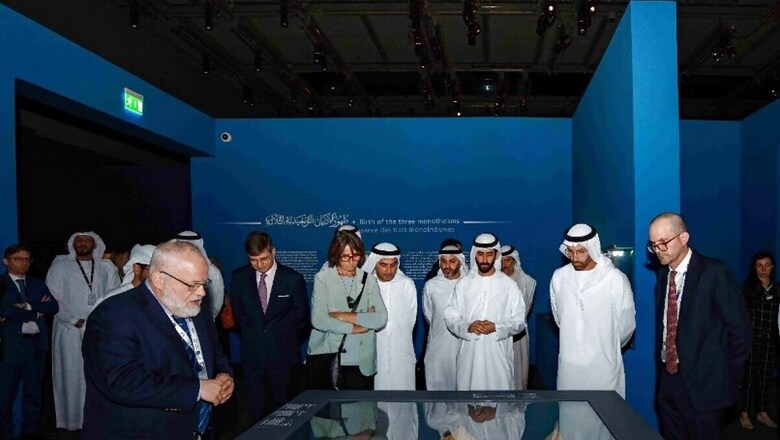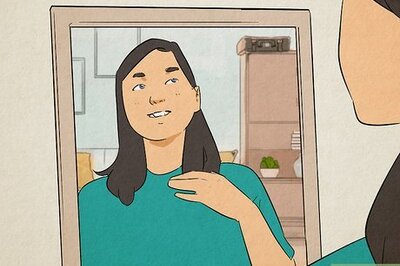
views
Louvre Abu Dhabi is pleased to announce that its latest exhibition, Letters of Light, was inaugurated by H.E. Mohamed Khalifa Al Mubarak, Chairman of Louvre Abu Dhabi today. Featuring some of the oldest texts of the three monotheistic religions, Letters of Light will open to public on 13 September and will run until 14 January 2024.
Held in partnership with Bibliothèque nationale de France and France Muséums, Letters of Light explores the historical context in which the holy books emerged, the way they have been passed down over the years, the scholarly and mystical practices associated with them and their essential role in universal intellectual and artistic history.
The exhibition is curated by Laurent Héricher, Head of the Oriental Manuscripts Department, Bibliothèque nationale de France, and Dr. Souraya Noujaim, Director of the Islamic Arts department, Musée du Louvre, and former Director for Scientific, Curatorial and Collections Management at Louvre Abu Dhabi.
With more than 240 artworks on display, visitors will discover important and beautiful manuscripts of the Quran, Bible, and Torah as well as artefacts from the collections of the Bibliothèque nationale de France, the Musée du Louvre in Paris and Louvre Abu Dhabi. These pieces include manuscripts, photographs, graphic arts and three-dimensional objects, textiles and paintings from all over the world. Offering a contemporary perspective, the exhibition also showcases a commissioned artwork by Muhannad Shono, The Unseen. The thread-based installation by the Saudi visual artist metaphorically connects the threads of the three religions through a contemplative experience.
Manuel Rabaté, Director, Louvre Abu Dhabi, says, “Letters of Light invites visitors to embark upon a journey of profound reflection, exploring the intricate interplay between creative ingenuity and spirituality. From exquisite texts like the Souvigny Bible to beautiful paintings such as Giovanni Bellini’s Virgin and Child, and intriguing artefacts like the Key to the Kaaba, this exhibition displays an array of remarkable items to highlight the shared origins of the three monotheistic religions — each an embodiment of beauty and knowledge. As one journeys through this captivating showcase, they’ll uncover how these three faiths share profound roots, enriching their understanding beyond personal beliefs.”
He added, “We are honoured to have partnered with Bibliothèque nationale de France and France Muséums to curate this exhibition, seamlessly bridging and fostering vibrant cultural connections.”
Laurent Héricher, Head of the Oriental Manuscripts Department, Bibliothèque nationale de France, says, “Presenting some of the oldest and most important books and manuscripts, extraordinary illuminated and marvelous calligraphy, this exhibition has been created to emphasise the universality of Quranic, biblical, and evangelical messages, as well as the intrinsic ethical dimension of these three religions and their predominant role in universal intellectual and artistic history. This fully aligns with the universal dimension of Louvre Abu Dhabi, a place open to dialogue that brings together different cultures to shed light on these common stories of humanity, transcending civilisations, eras, and places. We hope that this journey to the heart of the spiritual roots of human history invites visitors into a moment of meditation and aesthetic emotion.”
Dr. Souraya Noujaim, Director of the Islamic Arts department at Musée du Louvre, and former Scientific, Curatorial and Collections Management Director of Louvre Abu Dhabi, says, “By highlighting episodes and figures that are shared by all three monotheistic religions, we hope to deepen visitors’ understanding of these Holy Books, offering a retrospective on the rich history of sacred texts, exploring their forms, their languages, and the texts they contain. Letters of Light presents an extraordinary moment to see some of the rarest artworks, monotheist sacred scriptures, and items, displayed side-by-side. These include artefacts such as the Blue Quran, which translates the exhibition’s title ‘Letters of Light’ in its passages. This almost modern calligraphy, painted in golden letters contrasted by a deep blue background, conveys a reason for contemplation.”
Masterpieces from the exhibition include artworks and manuscripts from Louvre Abu Dhabi’s collection:
- Blue Quran folio, one of the most sumptuous ancient copies of the Quran to have survived to the present day. Consisting of seven volumes, the page was probably produced in Kairouan, Tunisia, in the 9th or 10th century. The dark blue page symbolises the celestial universe and the gilded letters the divine light spread by the word of God. A dedicated passage reassembling six pages of the dispersed Blue Quran will be included in the narrative.
- Palimpsest leaf of a Quran (Hijazi style), the script in the leaf on offer is described as Hijazi script. It is known to us from the 10th century Baghdadi writer Ibn al-Nadim as the earliest form of Arabic script. He attributes the script to Mecca and Medina, in the Hijaz region of the Arabian Peninsula, hence the name Hijazi links the script to its geographical origin.
- Virgin and child by Giovanni Bellini, an important piece of work that is representative of the early Venetian Renaissance and the art of Bellini. The technique of oil painting was at the time an innovation that distinguished Venice from the other centres of Italian art. The intensity of colour in the piece is accentuated by the use of a monochrome black background rather than the usual landscape, which was rare for Bellini.
The exhibition also features highlights on loan from Louvre Abu Dhabi’s partners, such as:
- Souvigny Bible with the representation of Abraham’s Bosom, late 12th century;
- Dead Sea Scrolls (oldest Hebrew bible manuscripts known), early 1st century;
- Gutenberg Bible, c. 1455–56;
- Key to the Kaaba in the name of Sultan al-Malik al-Nasir Faraj ibn Barquq, 1399–1412;
- Collection of prayers with hexagonal leaves, finely bound together and covered with text that unfolds from the lower binding flaps, 1744.
Visitors to the exhibition will also view the world’s smallest Bible to have travelled across space, the Nano Bible, which astronaut Eytan Stibbe brought to the International Space Station in April 2022. In addition, visitors will learn more about a great archaeological discovery, the ‘Ras Al Khaimah Hebrew gravestone. Discovered in the 1970s, the stele is engraved with the epitaph of a Jew who passed away in Ras Al Khaimah. It represents the first tangible evidence of Jewish presence in the United Arab Emirates.
As part of the museum’s cultural programming, Louvre Abu Dhabi will host a curatorial talk on 12 September from 5 – 6pm, offering insights from Laurent Héricher and Dr. Souraya Noujaim on the work that went into bringing the exhibition to life. A second talk, ‘Archaeology and Architecture’, will take place from 6:30 – 7:30pm, featuring a riveting panel including Dr. Timothy Power, Dr. Mark Jonathan Beech, and Manal Ataya.
The talks will feature national and international speakers from multiple disciplines, offering visitors the opportunity to delve deeper into seeing and reading the works of artistic and textual heritage selected for the exhibition, in the context of Louvre Abu Dhabi as a universal art museum. The talks will also bring attention to the living traditions of thought and practice that converse with the scriptures and scriptural legacies in contemporary contexts.













Comments
0 comment